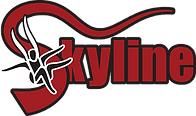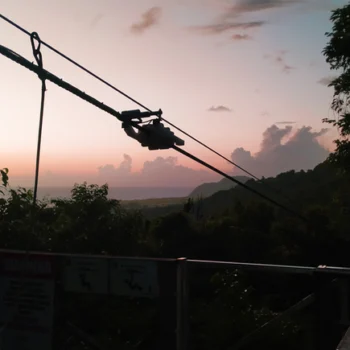Top 10 Questions Commercial Zipline Builders Ask (And the Answers You Need)
Building a commercial zipline course is exciting—but it’s also complex. Whether you’re constructing a single-line thrill ride or an extensive canopy tour, there are critical questions every builder needs answered before breaking ground.

Here are the top 10 most commonly asked questions commercial zipline builders face—and the expert answers that guide successful projects.
1. Is It Safe?
Safety is the foundation of any commercial zipline operation. A properly engineered course, using certified components, regular inspections, and trained staff can make ziplines incredibly safe.
However, accidents can still be caused when ziplines are installed by companies that don’t have enough experience, or sites that have not provided their operators with sufficient training. To make ziplines as safe as possible, modern equipment and technology should be used, and the engineering and installation should be done by a reputable company.
- Use tested and certified equipment (harnesses, trolleys, braking systems).
- Partner with a qualified engineer to calculate loads, forces, and tension.
- Install redundant safety systems, especially for braking and anchors.
- Implement a regular inspection and maintenance protocol—daily visual check s, monthly tension checks, and annual third-party audits are industry standards.
2. Do I Need Permits or Legal Approvals?
Yes—almost always. Commercial zipline construction is regulated to some degree in most regions.
- Check with local and national regulatory agencies (e.g., amusement ride inspectors, zoning boards, environmental authorities).
- Expect to need engineering stamps, insurance, and sometimes environmental assessments, especially if you’re building in protected areas.
- Consult with an attorney to draft liability waivers and understand your legal responsibilities as an operator.
3. How Do I Choose Anchor Points and Course Layout?
Anchor points are mission-critical. Commercial ziplines often use engineered poles, rock anchors, or large trees, depending on terrain.
- Choose natural elevation changes to reduce the need for tall structures.
- Conduct a site survey to evaluate anchor strength, distances, and rider path.
- If using trees, get an arborist to verify health and suitability. Tree anchors require specialized hardware to protect the tree and ensure longevity.
- In flat terrain, steel towers or platforms must be custom-designed and certified.
4. How Much Does It Cost to Build a Commercial Zipline?
Costs vary dramatically depending on site complexity, number of lines, and construction method. Skyline Ziplines offers the best-in-class turnkey solutions for zipline construction projects ensuring that from design to construction and training, all aspects of the project are covered with the highest possible quality and expertise. It is difficult to estimate a generic cost for construction of a zipline as costs can vary greatly depending on the line length, tower materials and heights, as well as logistical considerations; among other things.
- Costs include materials, labor, engineering, logistics (cranes, helicopters), and insurance.
- Additional costs include staff training, permitting, brand development, and marketing.
5. What Kind of Cable Should I Use—and How Thick?
Skyline only uses the highest quality galvanized steel cable. Depending on the length of the line different thicknesses are used for higher breaking strengths. Zipline cable is comprised of many smaller steel cables that are spun together during manufacturing. This results in a cable with a very high breaking strength and exceptional rigidity. It also ensures the cable is not compromised if one spool of cable is of a lesser quality than any other.
- ½” and ⅝” for moderate-length ziplines; require a safety factor of five to one.
- ¾” and ⅞” for long ziplines; require a safety factor of three to one.
NEVER use hardware store wire rope. Always source from a certified supplier and confirm specs with your engineer.
6. How Long and Steep Can a Zipline Safely Be?
The slope needed to build a zipline depends on the length and elevation of the proposed line. As a general rule of thumb, a slope of at least 6% is required for a flight that has enough speed to reach the braking system. You can calculate the slope of the planned line using the rise divided by the run (or the elevation loss over the length of the line segment). Other factors such as proximity to natural features and scenic landscape also lend themselves to ride quality.
- Typical commercial ziplines range from 300 to 2,000 feet, but some exceed 1 mile (5,280 ft).
7. What Kind of Braking System Should I Use?
Ziplines use different types of braking systems depending on the braking angle and braking speed.
Combinations of a pulley, redirect, hand braking, and spring brakes are often used. No Skyline builds use hand braking methods, and we err towards using a 2:1 spring brake system with a redirect rope. This places a catch block at the start of the braking system, with a rope anchored to the installed spring brakes to dissipate force and ensure the smoothest, safest braking experience possible.
8. Can I Build It Myself or Do I Need Professionals?
For commercial use: Hire professionals.
- Commercial zipline courses must be engineered, certified, and built to code.
- DIY methods are unsafe and not insurable for public use.
- Work with a zipline-specific design and build firm—ideally one that offers turnkey packages including layout, installation, inspection, and staff training.
Skyline Ziplines offers turnkey solutions covering all steps of the zipline build including the initial site discovery, design, engineering, fabrication, construction and installation, training, operations, and safety inspections. Working with Skyline means your project will be managed by industry professionals with decades of experience in the field and wont fall behind due to miscommunication or project mismanagement.
9. What Type of Trolley and Harness System Should I Use?
Trolley and harness selection affects safety, speed, and user experience.
- Use commercial-grade trolleys rated for continuous use like the skyTECH Rocket Trolley or Turbine Trolley
- Harness systems should be full-body for safety, especially on long or high-speed lines.
- Some operators use sit harnesses + chest harness combos for comfort and adjustability.
Skyline’s own skyTECH Twin-Harness is engineered for ziplining, whereas most operations use off-the-shelf climbing or fall-arrest harnesses. A separate secondary attachment point on the rear of the harness also serves as a travel restraint and secondary connection point to your zipline trolley.
It has the well-deserved reputation of being the industry’s most comfortable zipline harness for kids and adults. The design is based on traditional paragliding harnesses that are meant to be sat in for hours at a time.
10. How Do I Maintain and Inspect the Zipline Over Time?
Regular maintenance is non-negotiable.
- Daily: Visual inspection of all gear and connections.
- Weekly/Monthly: Check cable tension, wear points, and anchor condition.
- Annually: Schedule a third-party safety audit and full equipment inspection.
- Keep detailed logs of all maintenance and inspections—these are often required by insurers and regulators.
Annual zipline course inspections are paramount for safety (required more frequently depending on site usage). Skyline conducts ACCT-accredited safety inspections to determine site safety and effectiveness. A zipline system has many moving parts and, given safety factors like height, stability, and speed, among others, our certified inspectors can ensure peace of mind for facility owners and riders.
Invest in staff training to identify early signs of wear or unsafe conditions.
Building a commercial zipline is more than stringing a cable between two points—it’s a strategic, engineering-driven process that balances thrill, safety, and durability. By understanding and addressing these core questions from the start, you lay the groundwork for a successful and sustainable operation.
Need help with your next project? Contact our team of zipline construction experts for a consultation or quote. We’ll help bring your vision to life—from blueprint to first ride.
+1 (604) 905 – 4149
- Posted by Luka Wrenshall
- On May 5, 2025


